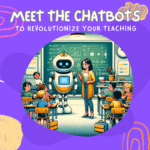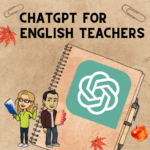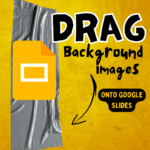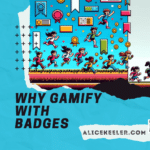Rightfully, there is concern that students will plug in assignment prompts into AI Chatbots such as ChatGPT and Google Bard in order to complete their assignments. As EdTech evolves, so do the tools that we use to facilitate teaching and learning. Artificial Intelligence (AI) offers a variety of benefits to the English Language Arts classroom, including improved personalization and support for learners. However, we need to ensure that these tools are used responsibly, maintaining academic integrity and the core purpose of English education. Here are some suggested elements to include in your acceptable use policy on your syllabus for your class.
Purpose of English Class and Assignments
The English Language Arts class aims to develop students’ skills in critical thinking, communication, literacy, and creativity. Assignments are designed not just to evaluate knowledge, but also to cultivate these skills, encouraging original thinking and personal growth. They are avenues for students to explore, articulate, and defend their ideas.
Academic Integrity and AI
Academic Integrity, in the context of AI use, means using AI tools ethically, responsibly, and as intended – to support your learning, not to bypass it. It implies producing work that is primarily your own, and appropriately acknowledging assistance received from AI.
Guidelines for AI Use
1. Supplemental Aid: AI can be used as a tool for assistance in brainstorming ideas, understanding complex texts, or improving grammar and syntax. However, the bulk of the thinking, analysis, and composition should be your own.
2. Reference and Citation: If significant insights or phrases are borrowed from AI, these should be properly cited, much as you would cite a human source.
3. Clarification, Not Substitution: Use AI for clarifying doubts or seeking explanations, not as a shortcut to avoid reading, analysis, and comprehension.
4. Learning, Not Completing: Use AI as a tool for learning, not just for task completion. Your primary goal should be understanding and skill development, not simply finishing an assignment.
5. Tutoring, Not Completing: Use AI to ask questions as you would your English teacher. Just as your English teacher would not provide “what are the answers,” neither should AI.
Violations of Policy
1. Unattributed Use: Copying significant portions of AI-generated content without appropriate citation.
2. Over-reliance: Leaning on AI to do most of the work, particularly the critical thinking or creative aspects of assignments.
3. Substitution: Using AI to bypass necessary steps in assignments, such as reading or analysis.
Please remember, the main purpose of education is to learn and grow, and while AI can be a helpful tool in that process, it cannot replace your active engagement and efforts. Let’s use AI responsibly, respecting the principles of academic integrity.
Chart of Acceptable Use
| Acceptable Uses | Unacceptable Use |
| Rewriting a reading passage at a simpler reading level. | Asking things like “What are the main points of the reading passage?” |
| Asking for clarification on a confusing concept or passage. | Requesting direct answers to specific questions or assignments without any effort to read or understand the material. |
| Seeking suggestions for additional resources or references related to the topic. | Asking for a summary or paraphrasing of the reading passage instead of reading it. |
| Requesting help with understanding complex vocabulary or sentence structures. | Asking for a complete essay or paper on the topic without doing the necessary research or writing. |
| Asking for guidance on how to analyze or approach a literary work. | Asking for the main points or key ideas of the reading passage without making any personal effort to comprehend it. |
| Seeking examples or explanations to enhance understanding of literary devices or techniques. | Requesting direct quotes or citations from the reading passage to use as evidence without independently identifying them. |
| Asking for suggestions on how you analyzed and interpreted a specific literary passage or poem. | Requesting a complete essay or analysis of a literary work without any personal analysis or effort. |
| Seeking guidance on how to structure an essay or formulate a thesis statement based on the reading material. | Requesting AI to write the entire essay or provide a ready-made thesis statement. |
| Asking for help in understanding the historical or cultural context of the literary work. | Requesting direct answers to discussion questions or assignments without reflecting on the material. |
| Requesting examples of effective writing techniques found in the reading passage. | Asking AI to generate fictional examples or provide content to plagiarize. |
| Seeking guidance on how to properly cite and reference sources used in an essay or project. | Asking for a pre-written bibliography or list of sources without conducting personal research. |
| Asking for suggestions on how to analyze character development or themes in a novel. | Requesting a detailed plot summary or book review without reading the book. |
| Seeking help in understanding the author’s writing style and its impact on the overall meaning of the text. | Asking for direct answers to multiple-choice questions or quizzes without attempting to answer them independently. |
| Asking for recommendations on related books or literary works to further explore the topic. | Requesting direct answers to essay prompts or assignments without constructing an original response. |
Sample Acceptable Prompts
Certainly! Here is a list of prompts that students in ELA could ask ChatGPT to enhance their learning and function as a personal tutor:
- “Can you make a list of literary device
- “How can I improve my essay’s introduction to make it more engaging?”
- “What are some effective strategies for analyzing and interpreting poetry?”
- “Can you recommend any classic novels that are similar in style to this author’s works?”
- “What are some techniques for developing strong character descriptions in my creative writing?”
- “Could you explain the concept of foreshadowing and provide examples from famous literature?”
- “Can you suggest some strategies for improving my vocabulary and expanding my word choices?”
- “How can I structure my argumentative essay to make it more persuasive?”
- “What are the key themes in this novel, and how do they contribute to the overall meaning of the story?”
- “Can you guide me on how to properly cite and reference sources in my research paper?”
- “What are some effective techniques for writing a compelling narrative?”
- “Can you recommend any contemporary authors known for their use of vivid imagery?”
- “How can I improve my ability to identify and analyze literary themes?”
- “What are the key elements to consider when crafting a strong argumentative essay?”
- “Can you suggest some strategies for improving my reading comprehension skills?”
- “What are some notable examples of symbolism in classic literature?”
- “How can I enhance the coherence and flow of my writing?”
- “Can you explain the concept of irony and provide examples from different literary works?”
- “What are some strategies for effectively analyzing and interpreting Shakespearean plays?”
- “How can I develop my skills in close reading and textual analysis?”
- “Can you provide tips for creating authentic and relatable dialogue in my stories?”
- “What are the characteristics of a well-developed and dynamic protagonist?”
- “How can I strengthen my ability to identify and analyze author’s tone in a text?”
- “Can you recommend some influential feminist authors and their notable works?”
- “What are some techniques for effectively incorporating evidence and quotes in my essays?”
- “How can I improve my ability to write concise and clear thesis statements?”
- “Can you explain the concept of allegory and provide examples from literature?”
- “What are some strategies for conducting effective research for an academic paper?”
- “How can I enhance my skills in identifying and analyzing rhetorical devices in speeches?”
- “Can you suggest some resources for expanding my knowledge of world literature?”
- “What are the characteristics of a well-structured and coherent paragraph?”
- “How can I effectively analyze and discuss the cultural context of a literary work?”
- “Can you provide guidance on how to write a strong conclusion for an essay?”
- “What are some strategies for improving my spelling and grammar in writing?”
- “How can I develop my ability to write vivid and descriptive sensory details?”
- “Can you recommend some influential authors known for their use of magical realism?”
- “What are some techniques for creating engaging and impactful opening lines in my stories?”
- “How can I enhance my skills in identifying and analyzing narrative point of view?”
- “What are some tips for crafting strong and effective thesis statements for literary analysis?”
- “Can you suggest resources for expanding my knowledge of different literary movements?”
- “How can I improve my skills in identifying and analyzing figurative language in poetry?”
- “What are some strategies for improving my critical thinking skills in literary analysis?”
- “Can you provide guidance on how to write a well-structured and persuasive argument?”
- “How can I enhance my ability to identify and analyze character motivations in a story?”
- “What are some notable examples of social commentary in literature?”
- “Can you recommend resources for expanding my understanding of postcolonial literature?”
- “What are some effective strategies for developing a strong narrative voice in my writing?”
- “How can I improve my ability to analyze and interpret non-fiction texts?”
- “What are some techniques for effectively using transitions in my writing?”
- “Can you suggest resources for expanding my knowledge of contemporary poetry?”
- “How can I enhance my ability to analyze and discuss the use of imagery in a poem?”
- “What are some strategies for improving my skills in recognizing and analyzing literary allusions?”
- “Can you provide guidance on how to write a comparative analysis essay?”
- “How can I develop my ability to identify”
Sample Unacceptable Prompts
- “Can you write my entire essay on this topic for me?”
- “What are the answers to the reading comprehension questions?”
- “Can you paraphrase this article for me so I don’t have to read it?”
- “What are the main points of the novel without me having to read it?”
- “Can you generate a poem that I can submit as my own work?”
- “What is the theme of the story?”
- “What is the main idea of the paragraph?”
- “What is the author’s purpose in writing this text?”
- “What is the tone of the text?”
- “What is the symbolism in the text?”
- “What is the foreshadowing in the text?”
- “What is the irony in the text?”
These prompts focus on seeking guidance, examples, and strategies to enhance learning and improve specific aspects of ELA skills. They encourage students to actively engage with the subject matter, expand their knowledge, and develop their writing and analytical abilities.












2 thoughts on “Acceptable Use Policy for AI in the ELA Classroom”
Thank you so much! This is incredibly helpful, especially the sample letter to students on acceptable use. I really appreciate your support! 🙂
Tara, I am so glad it is helpful!! I’d love to hear how it is going in your class. It’s challenging to stay ahead, working together and sharing practices helps.